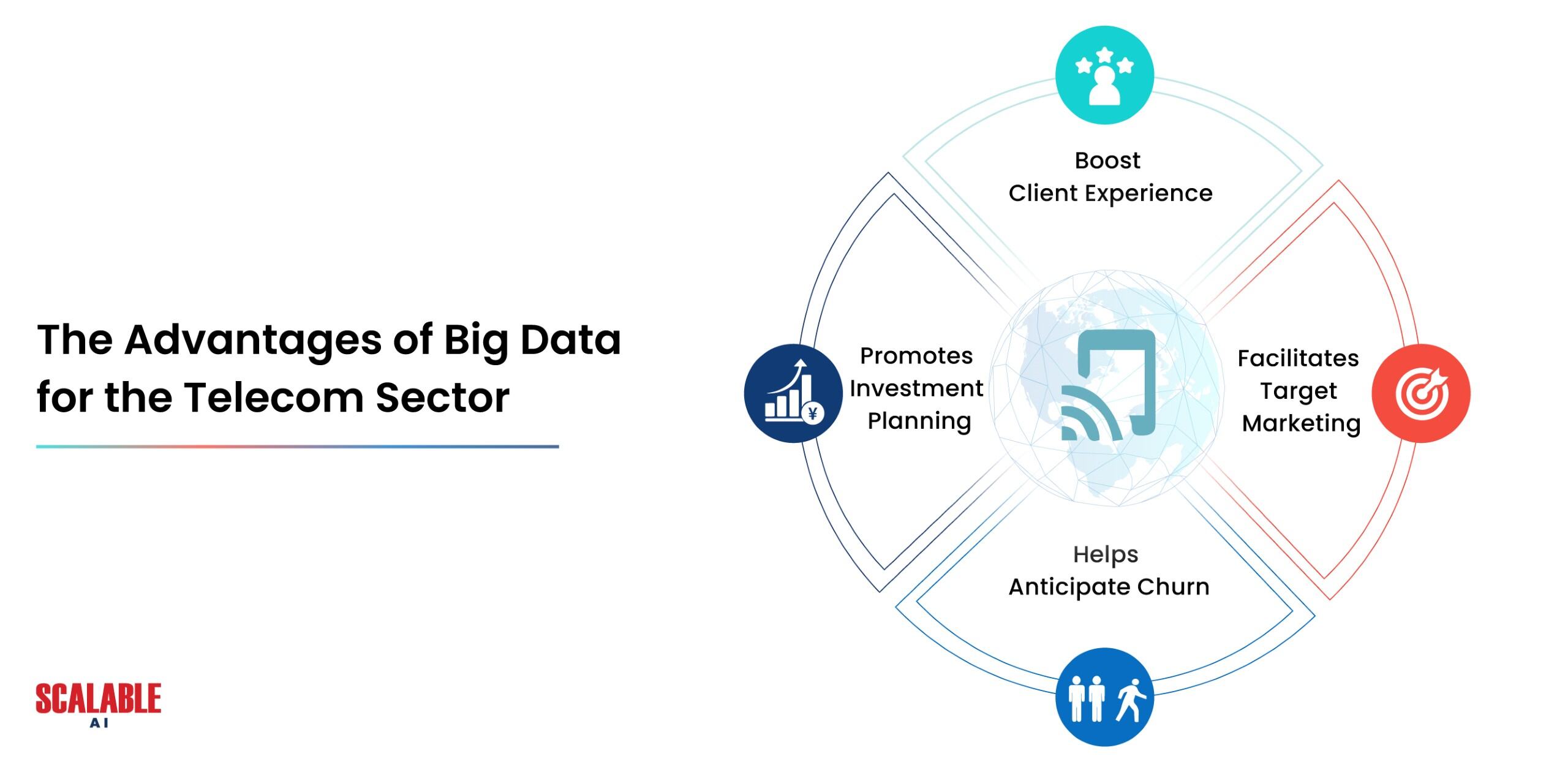These days, phone calls and telecoms play a crucial role in our daily lives. Large corporations in the market mostly compete with one another to offer the finest plans and services to consumers to make money.
The exponential growth in the quantity and usage of smartphones and mobile phones has overwhelmed telecom firms with various data that, if correctly translated and understood, might increase their profitability.
If the right inferences are made from this data, it can serve as the foundation for all necessary processes. Big Data analytics, for instance, can identify client data usage peaks, allowing businesses to plan and prevent any form of slowdown or issues.
Big Data: More Than Just Big
Data is defined as the stored information and recorded actions the computer carries out in various ways. This includes the given information as well as people and technology.
The amount of data known as “big data” is expanding exponentially over time. The scale and complexity of big data make it impossible for standard data management solutions to interpret and comprehend effectively.
To obtain the intended outcomes and comprehend and decode the data in terms of current concerns, big data analytics can be utilized to uncover previously overlooked patterns by using analytical understanding, and predefined conclusions are sought after.
Big Data Sources in the Telecom Sector
Due to the exponential growth in smartphone users, telecom companies already have access to vast amounts of data. Service providers can monitor regular customer profiles, device and network data, customer usage patterns, location data, downloaded apps, call durations, and other relevant information.
In terms of customer experience, network optimization, operational analysis, and data monetization, the organization can use such data to make genuinely insightful decisions and implementations.
The Advantages of Big Data for the Telecom Sector
Telecom firms can profit greatly from Big Data, which also gives them ideas for numerous solutions.
- Boost Client Experience:
Building a devoted customer base requires optimizing the customer experience. Big Data can provide categorized user information across the board, which can further personalize the customer’s experience.
To retain customers, companies provide the greatest services, offer prompt assistance during malfunctions, and resolve questions. Many telecom service providers create applications with automated chatbots that assist in problem-solving and prompt necessary action.
Before contacting a real person, customers can self-help themselves with a multitude of options available through services and customer care numbers.
The organization records every customer interaction, even when a real person speaks so that personnel can be educated to maximize profitability.
To retain clients and provide them with sufficient services, businesses can monitor the problems that arise from a specific location and work to resolve network connectivity or internet speed issues in that area.
- Targeted Marketing
By using consumer behavior, billing, and problem-redressal data, businesses can target their clients with the best services while also resolving their problems and maintaining their loyalty as customers.
For example, companies can create packs based on the number of customers’ previous purchases, offer extra data packs to attract people who don’t use them, provide free voice packs, and extend the day limit for the pack. All these strategies can be derived from the prevalent big data and used to benefit the company.
Companies can provide their customers with the “best offer” that encourages continued use of the services because they possess real-time knowledge about the pack expiry due date and data depletion before the renewal time of the day.
By combining information such as location and preferred content with customer demographics, purchase history, and clickstreams, we create the most beneficial pack. This pack has the potential to convert a viewer into a potential customer by sending them the appropriate push notification at the right moment.

- Anticipate Churn
Churn is a serious problem for any firm or sector since it measures how many people or things leave a collective industry over a given period.
Numerous factors, including service quality, network problems, social media trends, the availability of better options, unexpected price increases, and unanswered questions, could be to blame for this. Using the facts to comprehend such instances can always be a proactive strategy to lower churn.
In addition to proactively reaching out to return customers who have expressed dissatisfaction with the service on social media or who have complained about a string of poor service experiences, the companies can also target larger areas or specific locations to inconvenience individual users to reduce anomalies.
To stop clients from switching service providers, these problems can be resolved and discounts or service credits can be provided.
- Investment Planning
To become involved in this market and grow your network, you need contemporary setups, network expansion, and significant ongoing investments.
Strategic plans can be made by monitoring various needs and defaults using big data sources, which can help understand network usage and necessary extensions as the network may get congested during peak hours and lose customers without compromising service quality.
The business can decide whether to invest in expansions and resources related to anticipated traffic, strategic goals, expected ROI, future connectivity requirements, and customer experience, among other things.
Such strategic investments can aid in optimizing services while controlling those of competitors. In the event of any anticipated upgrades or pricing wars, these matters can be accurately managed using big data and strategies supported by hard facts.
Real-Time Analysis
Businesses can utilize big data to invest in real-time data analytics tools that enable them to monitor client situations in real-time. Based on these insights, real-time usage-influenced heat maps can help alleviate data congestion by informing the service provider when clients use data the most.
Depending on the amount of use and users in each location, network operators can adjust the cell towers’ range to suit demand.
Additionally, in the event of a decline in users and capacity that can be managed based on the data produced to avoid resource waste and preserve the company’s income.
Stopping Revenue Leaks
Without a plan, firms must keep up their cell towers and quickly solve network congestion, which costs them a lot of money and doesn’t even result in efficient sales.
Big data can help with these since it allows us to track data across years rather than just a few months and across all locations.
Pre-planning plant maintenance before it breaks down, updating systems based on market conditions and an expanded customer base, upgrading and replacing outdated techniques, etc., can all be done to save additional money that the companies don’t need to spend on immediate compensation or depletion.
Data Monetization
Numerous user-related data points, including subscriber demographics, subscriber location, network usage, device details, application usage, currencies, preferences, etc., can be gathered by telecom firms.
In turn, these data can provide insights into practical statistics that, while not directly utilized by telecom companies, can be very helpful to other companies.
These information aggregators are subject to certain terms and restrictions that the specific service providers must abide by.
To support business categories such as retail, financial services, advertising, healthcare, and public services, among others, with their campaigns and retargeting goals while also being able to personalize them and grow their business, telecom companies are being mindful of those and offering data analysis services without violating them.
Conclusion
Big Data offers many benefits for the telecom sector. Since it’s common knowledge that customers may leave if they don’t receive the expected services or resolutions, gaining insights into factors like timings, quality, location, user traffic, and maintenance records not only enables businesses to provide excellent customer service, but when done correctly, these measures can also significantly enhance revenue safety for businesses by optimizing the resources they have invested in.
Read Whitepaper Telecom’s Treasure Trove: Mining Customer Insights from Big Data
